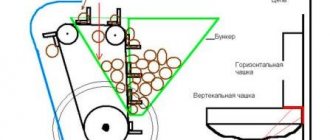What is a potato digger and its types
A potato digger is an agricultural technique used by farmers and private farmers to simplify the process of harvesting potatoes.
Main parts of a potato digger for a walk-behind tractor with your own hands:
- base - the metal base of the potato digger: this is a frame made of heavy-duty thick metal;
- the traction mount is responsible for fastening the mechanism's rods;
- vertical stands - needed to secure the knife-ploughshare on them;
- ploughshare - the main element of a potato digger, is a knife that goes deep into the ground, loosening the soil;
- adjusting rods - designed to adjust the angle of attack of the ploughshare;
- support wheels - necessary for moving the potato digger across the cultivated area.
Potato diggers for mini tractors are used on loose, medium-compacted soil.
Note! Regardless of the type, the operation of all devices is similar: the tool goes deep into the ground with its pointed part, moving along the beds, lifting soil layers with potato tubers.
There are the following potato diggers for the walk-behind tractor:
- fan-shaped (lancet);
- conveyor;
- vibrodynamic (screening).
Assembling a garden shredder with your own hands
Fan
A homemade fan potato digger for a walk-behind tractor is universal. The potato digger is structurally very simple. Its mechanism does not have rotating parts, which in other potato diggers quickly fail under heavy loads during harvesting. This species has other names: because of its characteristic appearance, they are called “paw” or pointed, and the industrial model is called Dolphin.
From experience with fan models for tractors, farmers using this type:
- ability to work with low-power walk-behind tractors;
- ease of connection with a walk-behind tractor;
- relatively low prices for industrial models;
- reliability;
- good cleaning speed.
The disadvantages of working with fan potato diggers include:
- the likelihood of loss of the potato crop occurs due to the small working width of the digger;
- part of the crop may be damaged by a knife, making it unusable.
Conveyor
The design of the conveyor potato digger for the walk-behind tractor is simple. In the center of the mechanism there is a transport belt, with the help of which the harvested crop of root crops moves upward along the belt, being cleared of dirt and adhering soil. The conveyor belt moves in a circle using the power from the rotating element of the walk-behind tractor through chains, a variator, and gears. You can make a potato digger with your own hands, but you need to follow the technique.
Advantages of a conveyor digger:
- does not damage potatoes;
- ease of operation;
- Compatible with high-power walk-behind tractors and small tractors.
The disadvantages of a conveyor CC include the likelihood of foreign objects getting into the conveyor, which can jam the mechanism and damage it.
Grohotnaya
The design of the vibrating CC, also called “screening”, is simple - the device consists of 3 parts:
- ploughshare;
- a movable grid with a vibrating mechanism that processes the harvested crop;
- metal carcass.
This type of CC is used in agricultural production for harvesting potatoes from large areas, sometimes on an industrial scale. The unit works like this: collecting and sifting tubers on a vibrating table is carried out through vibrations coming from a screening mechanism.
The advantages of using this unit include:
- wide coverage of the cultivated strip of soil;
- large depth of immersion of the knife into the ground;
- minor losses of potatoes during harvesting.
There are also disadvantages to using vibrating diggers:
- vibrations from the screening mechanism enter the control part of the walk-behind tractor, the impact of the vibration mechanism tires the body;
- Before working with CC, S-cleaning must be cleared of foreign plants that could clog the grate.
Types of potato diggers and principles of their operation
Almost every person who has at least once participated in potato harvesting is familiar with the work of potato diggers. For different types of devices, the general points are the same. First, special knives grab the soil, which ends up in a separate shaking mechanism. It is this that separates the potatoes from the ground; the soil crumbles earlier, and the potatoes lie on top; you just need to collect them. Different types of technology have their own fundamental differences. If you go to any agricultural equipment store, for example, in Moscow, the variety of models will surprise you.
Lancet universal
This version of the device is designed specifically for use with walk-behind tractors. Lancet potato diggers are very simple, which causes certain disadvantages. The biggest disadvantage of such a device is low performance. Using such a device, on average, only 85% of the crop can be raised to the top.
But the lancet potato digger for a walk-behind tractor has two significant advantages that can overcome any disadvantages:
- Low price, which is very important for small farms;
- Before using such a digger, there is no need for a power take-off shaft in the walk-behind tractor, which allows it to be successfully used with older models of walk-behind tractors.
Potato digger: do-it-yourself assembly
To assemble a vibrating potato digging device, the following materials are required: a thick metal corner (section 60x40) or a channel for making a frame, a thick steel sheet (6-8mm), a metal rod or fittings.
Additionally for the digger you will need:
- consumable fastenings (bolts/nuts/washers);
- steel pipe (diameter - 300mm);
- wide steel or rubber wheels.
The steel wheels of a homemade potato digger are inferior to rubber ones in terms of efficiency and maneuverability
When choosing rubber wheels, pay attention to the thickness of the tread, the width of the chamber - the wider, the more stable and passable the model will be
The process of manufacturing and assembling the cultivator:
- Weld the main frame of the device from corners or channels.
- Make sections from a steel sheet to strengthen the frame.
- Connect the frame with bolts or welding with reinforcing gussets.
- Then weld a grid of rods/reinforcements and steel strips.
- Attach a shaft to the grate, which is responsible for the vibration of the working digging unit.
- Afterwards, secure the elevator to the frame by welding and bolts.
Make a plowshare knife from a piece of steel pipe, cut it out using a grinder. Sharpen the ploughshare at the bottom. Connect the knife to the elevator and frame with thick bolts (diameter - 10mm).
Now make the wheel fasteners. Craftsmen recommend fixing the shaft for the wheels on the frame racks, but you can also install the wheels independently of each other on each side of the frame on the hubs. The completion of the assembly process is the installation of the wheels onto the shaft or frame hubs.
Potato Digger
This potato digging unit is also called a vibrating potato digger or shaking digger. A potato peeler consists of three parts: a knife, a moving grid with mechanisms that ensure its vibration, and a metal frame (frame).
A potato digger can be manufactured within a few hours; the work requires experience and skill in working with agricultural machinery. To make the unit you will need:
- Bulgarian;
- welding machine;
- drill, metal drills;
- metal profile with a square side of 2.5 cm;
- steel sheet 3-5 mm thick;
- steel wire with a diameter of 8 mm (or non-corrugated reinforcement of the same diameter);
- wheels;
- bolts, hinges, levers, eccentric, measuring tape, consumables.
You will also need a ruler and a pencil for marking. The procedure for making a potato screening machine:
- measure and cut the metal profile for the frame (frame);
- weld the frame;
- Wheel stands are welded at the bottom of the frame;
- inside the frame, holders for hinges are welded on which the screen will be suspended;
- brackets are welded to the frame for installing the gearbox and mechanisms that will create reciprocating movements (vibration) in the unit;
- a sifter box (screen) is welded from metal rods;
- the screen is hung on hinges inside the frame;
- A gearbox and other equipment for creating vibration are attached to the brackets, and they are connected to the screen. During operation, the rotation of the walk-behind tractor shaft is transmitted through mechanisms (lever and connecting rod) to the screen, vibrations create rotation of the eccentric;
- a potato digger knife is cut out of a steel sheet and bent to the desired shape;
- the plowshare knife is hinged and attached to the bottom of the frame and the screen;
- Wheels are put on the unit and secured.
The ploughshare-knife for a gravity potato digger is made in different shapes. It can be bent and pointed, convex and concave. Digging potatoes proceeds as follows:
- The ploughshare goes deep into the soil and cuts it along with the tubers.
- The knife constantly oscillates in accordance with the vibrations of the screen, cuts off the soil with potatoes and throws the tubers up a little into the screen. The rumbler performs vibrating, reciprocating movements in the frame.
- The peeled tubers roll off the grate and fall onto the arable land behind the potato digger (or on the side of the strip, depending on the design of the unit).
Homemade conveyor potato digger for walk-behind tractor
The conveyor model is quite suitable for working in extreme conditions and heavy dust. This is a high-precision, high-speed device, if the assembly is carried out correctly and the components are securely mounted. The digger allows you to mechanize almost the entire assembly process if you install a receiving hopper in addition to a mini-tractor or walk-behind tractor, which will save money and manual labor when harvesting potatoes. In addition, improvised material can always be picked up at a landfill or at home in the garage of craftsmen. Any old mechanisms will do the job.
Conveyor potato digger for walk-behind tractor
Stages of work to create a conveyor unit:
- take a steel profile with a square cross-section and weld a frame from it;
- make a ploughshare knife from sheet steel;
- install the roller in the frame for mounting the conveyor belt;
- assemble a conveyor belt from chains and rods;
- attach brackets to the gearbox;
- install the conveyor belt and mechanisms into the frame;
- mount the wheels and plowshare to the frame.
Today, digging potatoes on a plot with a shovel is practically a thing of history. Modern potato diggers for walk-behind tractors allow you to harvest crops much faster. At the same time, it is not necessary to buy expensive equipment for production. It is enough to quickly make it from scrap materials, simplifying the harvesting process.
Note! To know how to properly make a potato digger with your own hands for a walk-behind tractor, it is important to study in advance the types and structure of various models, determine the optimal dimensions, make drawings, a diagram and inquire about the density of the soil on the site. This is the only way to choose the best option for manufacturing a mechanized device without loss of yield.
Design Features
To cultivate a small plot of land with good loose soil, a walk-behind tractor is most often used; maintaining it in working condition and providing it with fuel and lubricants does not require large financial expenditures. It is extremely difficult to manually remove potatoes from the beds, even in a small area. Therefore, the owners of such plots make or buy simple accessories for the walk-behind tractor. A fan potato digger is similar to a hiller, but instead of the characteristic wings there are steel rods arranged in the shape of a fan.
This potato digger for harvesting with steel boom rods is one of the simplest mechanisms. Install it on small tractors or walk-behind tractors. It is made easily, by analogy with a bayonet shovel. It is made from a metal sheet bent in a special way and several rods welded to it like a fan to sift out the soil. Average digger dimensions: height – 500 mm, width – 330 mm, weight – 5.5 kg.
Fan potato digger
Do-it-yourself conveyor CC to a walk-behind tractor
Conveyor diggers can be made in both small sizes, intended for small households, and large ones, which are used in agricultural production. The manufacturing process of a conveyor-type digger is quite complex compared to simple types. Therefore, without sufficient experience in the manufacture of such mechanisms, it is better to buy a ready-made unit at an agricultural equipment store.
Recommendation! It is better to make a conveyor device using diagrams and drawings of production sample models.
Let's consider the main stages of the manufacturing and assembly process of a conveyor potato digger for a walk-behind tractor for digging potatoes:
- Welding a frame from a steel profile and corners.
- Cutting a ploughshare knife from a piece of steel.
- Insertion of wheels or shafts for the conveyor belt mechanism into the main frame.
- Creation of a belt conveyor from a chain and reinforcement blanks.
- Installing fasteners and brackets to secure the gearbox and gear.
- Installation of transport belt and other devices on the frame.
- Installation into the frame part of the share and wheels.
A manual potato digger is easier to make, but more difficult to operate.
Rodent repellers, characteristics
How to make a potato planter with your own hands
Let's look at what a homemade potato planter for a mini tractor is.
With the onset of spring, potato tubers are prepared for planting in the ground. To facilitate the process, use a special planter. The potato planter for a mini tractor can be single-row or double-row. In addition, they are simple, without support wheels and with wheels. Single-row technology is adapted for planting tubers in one row. In the case of a double-row, two rows are simultaneously processed and sown. The row spacing can be adjusted.
You can make models with lugs. In such a unit, the function of wheels is performed by lugs. They, thanks to the chain mechanism, set in motion the conveyor belt for supplying tubers. To create even rows, the device has a disc hiller and a plow for forming a furrow.
The two-row potato planter for a mini tractor fits well with mini tractors and has a hydraulic drive. Unlike a single-row planter, this model has two hoppers for filling planting tubers. The size of the capacity depends on the model of the unit.
Planting potatoes with a mini tractor completely automates the work. This is a very convenient device, but unfortunately many people cannot afford it. You can make such a device yourself, maintaining the principle of conveyor work.
To make a potato planter with your own hands for a tractor you will need:
- container or bunker for filling planting tubers;
- frame with wheels;
- device for digging ditches;
- tape with attached bowls for capturing potatoes;
- discs for filling planted tubers.
First, a frame with wheels is assembled, to which all other parts will be attached. After this, a mount is welded to couple the unit with the tractor and a longitudinal axis is installed on which the bunker will be supported. It can be made from wood, or you can use any suitable container, for example, a tank from an old washing machine. A metal pipe with a spacious hole can be used as a seeder.
Before you start assembling such a unit, you should definitely read the relevant literature or watch a video. It is not worth taking on the design without a preliminary drawing. For planting potatoes, a home-made digger can be designed for a tractor, or it can be combined with another device. Often, after assembly, the cost of manufacturing the unit is more expensive than expected, and the price difference with ready-made equipment is so insignificant that it is better to purchase ready-made equipment.
A homemade potato planter must be assembled without errors, otherwise the sowing process will be labor-intensive and long. The calculation should include absolutely everything: row spacing, distance between planted potatoes, planting depth, etc.
How to attach a potato digger to a walk-behind tractor?
The possibility of attaching a potato digger to a walk-behind tractor completely depends on the design and the unit used - the following general points can be highlighted:
- The main condition for normal operation is the power ratio between the walk-behind tractor and the unit. In practice, this means that it is not advisable to attach a powerful walk-behind tractor to weak fan-shaped potato diggers.
- Size ratio. Aspect ratio is one of the key parameters during installation. When making a potato digger yourself, you need to decide on the purchase of a walk-behind tractor (if you don’t have one), and then, according to the drawings, make the mechanism in relation to the parameters of the walk-behind tractor.
- Correspondence between the potato digger mount and the walk-behind tractor mount. The main thing when making a structure is to correlate the mounting of the walk-behind tractor and the structure itself.
A potato digger is a good helper for summer residents due to its efficiency. With economical fuel consumption, it is possible to quickly process a large sown area and with low yield loss, while the time taken is much faster than when working with a shovel.
Review of popular models
It is not always possible to have the necessary materials and desire to make a potato digger for a tractor yourself. It will be much easier to buy a device if you do not have the appropriate skills and abilities required to assemble the unit yourself. There are many models on sale, among which several products are considered the most popular. These are screening and conveyor diggers of the Scout brand, which are distinguished by their affordable cost and the ability to be used with an impressive list of equipment. The greatest compatibility is demonstrated when working with the tractor series of the same name.
Another popular option is the KKM-3 model , which belongs to the category of vibration devices. It is lightweight and can be used with MTZ mini tractors, as well as other units similar to them in design.
How to make a potato digger for a mini tractor with your own hands
Let's consider making a potato digger for a mini tractor with your own hands. The conveyor potato digger can be assembled by hand. To do this, you need to have drawings on hand on which all parts of the unit will be outlined in detail.
How much more expedient it is to make such equipment yourself is up to everyone to decide, but it should be taken into account that a homemade potato digger is suitable for plowing a small area. Large areas are best treated with industrial equipment purchased from the manufacturer. When harvesting potatoes, a digger, made by hand for a tractor, passes through the area, digs up and collects the tubers.
In order to assemble a passive type weapon, you will need materials. First of all, a sheet of iron made of durable steel, which will serve as a shovel. It is advisable that its width be at least 3-5 mm, otherwise the iron will quickly become dull. Many people use circular disks, from which two sectors are cut out and welded together. This steel is much more durable and lasts longer.
Rebar rods are suitable for sifting out soil. They are welded on the back of the shovel.
You can use a metal channel as a suspension, having previously calculated the depth of immersion in the ground.
The blade part should be shaped like a triangle for better immersion into the soil. The device is attached to the walk-behind tractor using fasteners and requires normal movement along the rows planted with potatoes.
You can make a potato grinder for a tractor with your own hands. The assembly of this design is more complicated than the previous one, so you will need a pre-thought-out diagram. To avoid rapid breakdown, a homemade potato digger must be made of high-quality materials. To create an efficient structure, it makes sense to spend a little more time on it, and it will pay off in savings on the time spent on plowing and harvesting.
A homemade potato digger for a tractor is made from the following materials:
- metal profile pipe for the frame;
- iron layer (3-4 mm) for the ladle;
- iron fittings;
- metal channel for vertical traction;
- hub from the front of any car;
- gearbox;
- a driveshaft may come in handy;
- splined connection from the gearbox;
- one or two wheels (depending on the type of device);
- fastening elements;
- tools: drill, grinder, welding machine.
The height of the device above the ground will depend on the size of the wheel. The frame rests on two support points. The gearbox is activated either by the wheels or by the power take-off shaft of the cultivator. The spline connection is necessary for the mobility of the share and the oscillatory movements of the lattice.
The harvesting method will depend on the angle of inclination of the lattice part. If the screening part is tilted downwards too much, the potatoes will fall to the ground. When you change the angle of inclination and lift the lattice part up, the tubers will linger on the mesh, and then they can be collected directly into the bag, but for this you will need to constantly stop the machine.
A do-it-yourself potato digger can have any shape and size, it all depends on the choice of the designer
It is important to maintain the principle of operation, which involves raking the soil with potato tubers into a grid in which they will be sifted. Homemade potato diggers for mini tractors can be made from old machine parts and any available materials
The most important thing is that the potato digger meets all safety standards and does not cause injury during operation.
Making your own lancet digger
A homemade potato digger for a lancet-type walk-behind tractor is a simple type of attachment. In some ways it is similar to a cultivator. To construct it, you do not need a lot of material and complex tools. The assembly operations are simple and, with minimal skills, can be done by any gardener.
Necessary materials:
- steel channel;
- plow - it can be cut from an old shovel or a circular saw, but it is better to take high-quality steel with a thickness of at least 5 mm;
- metal corners 40 and 63 cm;
- steel rods in the amount of 8 pieces - can be removed from used forks or broken garden tools and replaced with fittings.
The device should ultimately be small in size. It needs to be made so that it is easy to attach to the Neva walk-behind tractor. There are no moving parts in the lancet digger, so there is nothing to break. The main thing is that the structure itself can withstand and not crack.
Manufacturing procedure:
- The channel is used as a base. A tow hitch is mounted on it.
- A plow is placed on the base.
- Rods are welded to the plow, which separate the tubers from the sand.
Disadvantages of the device:
- The small width of the strip is about 25 cm, because of this, crop losses increase by about 15-20%.
- There is a high risk of damage to the tubers from the knife.
The grass should not clog the bars during operation. Otherwise, the device will stop performing its function and begin to crush the potatoes. Despite its shortcomings, it can be used in a small backyard in the southern regions. The wider the plow is made, the better.
Manufacturing and assembly
First, you need to weld a frame from metal corners and a channel (or pipes). The entire structure will rest on it. The length of our frame is about 120 cm.
We move down 30 cm from the frame and weld another channel or pipe for mounting the regulating parts of the digger.
Starting from one of the edges, we weld metal posts (vertically to the ground). The length step of the racks is 10 cm (first the long one is 50 cm, then the smaller ones are 40 cm, 30 cm). We weld the base to them, on which the bars of the grill will be located.
We connect the metal racks together with the remains of the channel. After cooking they should resemble a triangle.
A metal plate (made of sheet metal, about 30 cm wide) needs to be welded to one of the triangles. After the welding has completely cooled down, you need to bend it with a sledgehammer and secure it to the second triangle. The ploughshare can be made from sharpened metal plates (2 pieces), an old plow or a piece of pipe (200 mm), which should be bent like a plow and sharpened well. The share is attached to the elevator with bolts (size 10).
We weld the reinforcement to the base, starting from the side of the metal plate. The other side of her walks freely. The gap between the reinforcement is 4–4.5 cm. Thick sheet metal can be welded on the sides of the rods. This will prevent the root vegetables from falling out of the sides of the grill.
Instead of an elevator, a cleaning drum can be used. It is a half-cylinder made of reinforcement (section 10 mm), attached to a frame.
We install shafts on the resulting elevator (grid) that react to the rotation of the wheel and set the grate in motion (vibration).
Step 8
We attach the reduction block to the rod using bearings.
We assemble the support-transport unit (wheels, roller chains, metal disks and rod). The chains transmit rotational movements to the shafts. The rod, which acts as a connecting bridge, is secured with sprockets. Disks are welded to it, to which the wheels are attached.
Mount for walk-behind tractor
or tractors in the same way as fastening other equipment to them.
What is needed to assemble a homemade potato digger?
The basis of this type of attachment is usually a welded frame made of metal corners. The thickness of the metal is selected taking into account the load it will experience.
The larger it is, the thicker the sheet of metal should be. The most commonly used corners are those with overall dimensions of 63×40 mm. You will also need an iron channel made of durable metal.
Ideally for this case, a part marked with number 8 is suitable. In addition, sheets of metal of various sizes, with a thickness of at least 8 mm, are required.
If everything will be connected with bolts, you should purchase the required amount of hardware.
You will also need:
- a chain that will transmit torque;
- wheels - metal or rubber, depending on the type of soil on which you will have to work;
- metal drum;
- gas pipe with a diameter of ¼.
How to cook ralo?
To make a ralo, you should weld two holes for a bolt of size M12 in a sheet of metal measuring 40x40 cm and 0.3 mm thick. Exactly the same holes are made in the racks. In this case, you should retreat 50 mm from below. The leaf curls tightly. High quality nuts and drill are used.
A sheet of the same size is welded on the reverse side. Then another sheet of metal measuring 70x30 cm and 0.4 mm thick is used. It is butt welded to the side sheets.
The center is hit with a sledgehammer. The metal should take the shape of a cone. The pitched board is welded. One ends of the metal rods, the diameter of which is 10 mm (fittings are suitable), are soldered to the rail from below. The other ends extend beyond the base of the device. The length of the reinforcement should be 120 cm.
To provide reinforcement that prevents the rods from wobbling in the air, a 30 cm long riser should be welded at the end of the frame. A square pipe is welded from one riser to another (you can use a bar to which rods are welded). This achieves stability. About two thirds of the length will come out. The edges of the rods should be left free. They will vibrate when the potato digger is in operation and will ensure better removal of the tubers from the ground.
Build process
The assembly process is regulated by basic rules, as well as the features of the device. Each type of mechanism has its own order and assembly conditions. With the exception of the standard rules, several conditions must be met:
- the connection of structural elements is carried out on the basis of an existing platform or eye;
- Initially, it is the supporting structural element that is installed;
- the parts are adjusted in accordance with the parameters indicated in the drawing or diagram;
- the assembly process is divided into stages, depending on the complexity of the design;
- The last stage is fitting the design to the equipment and a test run.
The last stage in the assembly is the most important, as it allows you to eliminate deficiencies before the main work process begins.
The most difficult option is to create a homemade screening (vibrating structure). Self-assembly process:
- the first stage is considered the moment of creating the frame;
- the frame is constructed from 4 corners: 2 – 0.8 m each, 2 – 1.2 m each;
- Several jumpers are attached to the resulting rectangle, through which the equipment is controlled thanks to vertical traction;
- a shaft for the wheel system is attached;
- several racks and a metal sheet are installed on them;
- after this, a lattice base is created;
- The last step is to install the wheels and adjusting rods.
A potato planter on a walk-behind tractor is considered ready after checking the operation, and not after securing the entire structure.
With small errors in calculations, the design may have defects or the tuber assembly process may be carried out incorrectly. If you do not follow the established calculations and circuit parameters, then installing the mechanism on the equipment itself will become problematic. During the manufacturing process, it is necessary to constantly check the dimensions with the required dimensions.
This is interesting: a disc hiller for the Neva MB 2 walk-behind tractor.
Most homemade options have a simpler collection pattern than the type presented. For example, the fan type, that is, an ordinary lancet potato planter on a walk-behind tractor, is easy to assemble. A knife is installed on a base, including corners and several fasteners, which is surrounded by rows of metal pins. The main point is the correct placement of the rods, as this will affect the efficiency of the assembly.
Many types of home-made structures are universal and differ from conveyor models only in parameters and dimensions.
Collecting root crops using a walk-behind tractor and devices installed on it is preferable to the manual method. You can either purchase a potato digger for a specific model of equipment, or you can design it yourself. Each type of mechanism has its own characteristics and difficulties in manufacturing.
Reviews
People who have created a potato digger on their own share their positive experience in using it. In addition to the fact that it effectively copes with the task, the owner can be confident in its reliability, knowing that it is designed using thick-walled metal materials. In some cases, owners have to modify the design due to accidental errors during creation.
Be sure to read: Tractor Scout T-15: weight and other characteristics
When creating a potato digger yourself, you should additionally take care of purchasing parts such as bearings, disks, rods and sprockets. They tend to wear out during use. Parts purchased in advance will save the owner from wasting time searching for spare parts.
Types of potato diggers
Such units differ in size, working width and design features. If you are interested in a homemade potato digger, then first consider the features of each type of such device. The most popular are screening and fan units, but more experienced craftsmen are able to make drum and conveyor potato diggers. More details about the types of construction:
- Fan (lancet). Due to the characteristic shape of the plow, manufacturers often call this type of unit “Dolphin”. This is the simplest version of a potato digger and is inexpensive. It easily adapts to any model of mini-tractor or walk-behind tractor. There are no movable parts in the design. The principle of operation is that the soil with tubers is cut with a knife, after which the cut falls on the surface of the rods, where the soil is poured back. In this case, the tubers in their pure form lie on top of the soil. This type of digger is good for soil with low density, but it has relatively low efficiency - it lifts about 85% of the crop to the top.
- Vibrating (screening). Compared to the previous ones, they are more effective - they extract up to 98% of tubers from the soil. The mechanism of operation is as follows: the top layers along with the potatoes are picked up and placed on a vibrating table. Then, under the influence of vibration, the soil begins to peel off and escape through the cracks. The potatoes will fall out on the other side of the device. This potato digger is also suitable for collecting other vegetables. The downside is the complexity of manufacturing.
- Transporter. They can freely work on the basis of such walk-behind tractors as “Neva”. The design is very similar to vibration devices - they consist of a ploughshare and a moving conveyor. The latter has a special hooking device that supports the tubers on the platform and clears them of soil. The conveyor unit is more practical than the vibrating unit. The downside is that it is not practical to use on lightly compacted soil. It costs more than its fan counterpart.
- Drums. A potato digger equipped with a drum is used to process fields using a mini tractor. The mechanism of action involves the rotation of a lattice structure, due to which the potato tubers are cleared of soil. But users of the drum potato digger note that the potato peel is damaged in the drum. Homemade devices of this type are rare, because their manufacture is not an easy task, because it involves studying diagrams and drawings.
Fan potato digger for walk-behind tractor
The fan potato digger has several names. It is also called a lancet digger and a paw. Manufacturers of agricultural machinery call this model “Dolphin” because of the characteristic shape of the plow (ploughshare). The unit is simple in design and removes tubers from the ground well.
- The digger is attached to the walk-behind tractor.
- The sharp end of the ploughshare loosens the ground.
- The potatoes are removed from the ground, placed on the inclined surface of the ploughshare, and pushed onto metal rods.
- The soil is separated from the tubers and poured onto the arable land through the twigs.
- The potatoes move up the raised rods and fall to the ground where they can be collected.
Digging with a fan digger allows the presence of rare and low weeds in the field. Potato tops are mown before harvesting.
Making a fan potato digger with your own hands
To work you will need a grinder, a welding machine, a drill and metal drills, and bolts. You will also need materials:
- sheet steel 3-4 mm thick for making a knife (ploughshare);
- bolts with a diameter of 10-12 mm or more;
- steel profile of rectangular section or thick steel sheet for the manufacture of a rack-holder and bracket.
- round steel rod or fittings (not corrugated) with a diameter of 8-10 mm.
In addition, you will need a measuring tape and a pencil for drawing on metal. The procedure for making a fan potato digger:
- Two holes are drilled in the middle part of the ploughshare for fastening to the stand.
- Pieces of steel rods are welded to the expanded part of the knife (to the left and right of the convex part) (so that they fan out upward and to the sides). The length of the rods is 47-50 cm. Sometimes the rods are bent in the form of a marching step.
- The holder stand is bolted to the plowshare. The height of the stand depends on the design of the walk-behind tractor. The support post can be welded directly to the plow without using bolts.
- A bracket with pre-drilled holes is welded to the top of the rack (to connect the potato digger to the walk-behind tractor).
- For structural strength, the lower part of the ploughshare, directed towards the ground, is reinforced with a welded strip of metal.
The advantage of a fan potato digger over other units is its reliability. This unit can be used for more than one year. It has no rotating parts, which become unusable under heavy loads. Potato digging is done quickly and efficiently.
The disadvantages of the unit include the small width of the dug strip (20-25 cm), due to which crop losses reach 20%. The knife of a fan potato digger damages some of the tubers, making them unsuitable for long-term storage and sale.
Potato digger for a walk-behind tractor using a screening crop separator
This design is more complex to manufacture, but the performance is 2-3 times higher than the previous model. If your vegetable garden planted with potatoes has an area of several hundred square meters, it makes sense to spend time creating an effective device. It will pay for itself in the effort saved during harvesting.
For production you will need:
- Profiled pipe for making a frame;
- Steel sheet 3-4 mm thick for the ladle;
- Circle or reinforcement made of ordinary steel;
- Channel 30-30 mm for vertical rods;
- The front hub is from any rear-wheel drive car, from the same Zhiguli;
- Gearbox from the rear axle of a VAZ classic;
- Cardan shaft (if connected to the power take-off shaft);
- Spline connection from an old gearbox;
- Wheel from old agricultural machinery (you can buy ready-made);
- Welding machine, grinder, drill;
- Fastening elements.
A potato digger for a walk-behind tractor of this design rests independently on the ground with the help of one or two wheels. The operating principle is shown in the illustration:
The supporting frame has two support points. The suspension for the walk-behind tractor is a traction device. Support wheels regulate the height of the structure above the field.
The gearbox is driven by the power take-off shaft of the walk-behind tractor, or connected to the wheels of the potato digger. The rod, one end connected to the crank mechanism, performs oscillatory movements.
The spline drives the ploughshare (moves back and forth like an excavator bucket) and the screen (moves sideways like a dog's tail). As a result, each portion of dug potatoes is separated from the soil and collected in a lattice storage tank.
If the drive has a positive tilt angle, you can periodically stop the movement and unload the peeled potatoes into bags. Or set a negative angle, then the tubers will be evenly unloaded on top of the soil for subsequent drying and harvesting.
Important! if it is necessary to harvest potatoes in wet soil (for example, after rain), you need to change the angle of work and the depth of immersion of the ploughshare.
To do this, provide an adjusting screw rod.
If such a design is too complex to implement, a simpler one can be made, with the same vibration separator. A homemade potato digger gives a lot of scope for creative thought. This design sifts the crop along the movement of the walk-behind tractor. The bucket ploughshare scoops the potatoes into the grate, which makes a reciprocating movement back and forth. For this purpose, the suspension is made on swinging hinges.
The vibrator drive itself is made of a pipe and an eccentric connected by a shaft to a pulley. The pulley (located on top of the frame in the illustration) is connected to the wheel using a belt drive. Or, using an angular gearbox, it can be connected to the power take-off shaft of your walk-behind tractor.
The sifted potatoes are shipped to the bed behind the device. Or, as it accumulates, you can stop the movement and load the crop into containers.
Conclusion: the listed structures are actually made from rubbish, which is present in any farmstead. If there is a need to purchase any components, they will not greatly increase the cost of the structure. Especially in comparison with the factory copy.
Important! A homemade potato digger can cause injury
Therefore, when operating, take basic precautions.. Potato digger for walk-behind tractor, video instructions for detailed manufacturing
Potato digger for walk-behind tractor, video instructions for detailed production.
The potato digger for the walk-behind tractor is a mounted device and is used together with the walk-behind tractor. The efficiency of its work is high. It is capable of cultivating not only a plot of land, but also a field. Its main function is to separate tubers from the soil and then lay them on the surface of the site.
Making your own potato digger
Potato digger
The most convenient high-quality model would be a vibrating potato digger for a mini tractor. This section provides instructions for its manufacture. In the process of creating this unit yourself, you need to take into account that the durability of the mechanism is ensured by the quality of the steel used and the strength of the connections. The latter can be achieved by bolted connections or welding.
Frame
The basis on which the entire structure in this device will need to be secured is a rectangular frame. It is made from a square pipe 4 by 4 cm. It is welded in such a way as to form a rectangle measuring 80 by 100 cm.
On this frame you need to install fasteners going down. A ploughshare, a vibrating grid and wheel holders will be attached to them. A mechanism will be installed on top of it, which will ensure the vibration of the basket.
Homemade potato digger
ploughshare
This knife will lift potatoes mixed with soil into a basket, intended for processing. The fastenings for it are located on the sides in the front of the frame. The share is usually a strip of strong steel that must be bent accordingly. In this case, the middle should be located horizontally, the edges should look up. The front edge of the share should be well sharpened.
Wheels
Here they are not only a means of transportation, but also allow you to adjust the depth of the ploughshare. The hubs are connected to vertical metal pipes with a cross-section of 3 by 3 cm.
Two square pieces of pipe located vertically are welded to the rear of the frame from the sides. Their cross-section should be 4 by 4 cm. The vertical posts from the wheels are threaded into these pipes and secured with bolts. The wheels are on an axle that, apart from them, is not connected to anything else.
If the owner wants to increase the depth at which the plowshare works, then to do this it is enough to move the vertical wheels of the wheels up a little. If this depth needs to be reduced, the wheel height will need to be adjusted in the opposite direction.
Note! It is advisable to prepare at least two pairs of wheels for work. The first of them should be on a rubber run. It is suitable if you have to work on soft or wet soil. The second is wheels with a steel rim. They will be convenient if the soil is hard.
Net
It consists of metal rods located parallel to each other. The distance between them is such that potatoes cannot fall between them. In the mesh, the rods are located parallel to the direction of movement. In the transverse direction they are fastened with narrow steel strips, to which the rods must be welded. Their edges are curved upward and are attached to special holders, which are attached to a mechanism that vibrates the basket.
Net for potato digger
Mini tractor clutch
A mechanism is attached to the front of the frame by welding and is designed to be attached to a mini tractor as a suspension.
DIY drum potato digger
Drum type potato digger
It works as follows. Its design includes a ploughshare; when the mechanical rotary walk-behind tractor moves forward, it cuts into the ground. Moreover, its depth exceeds that at which the potatoes should be located. During movement, the potatoes, mixed with soil, gradually move backward and fall into the drum, the axis of which is located horizontally, parallel to the line of movement.
The drum rotates. In this case, the earth wakes up between the rods, and only root vegetables remain in the drum. Moving backwards, they fall to the ground. They can then be collected manually from the ground surface into an appropriate container. This device is in-line - it works by sequentially processing the beds one after another.
This kind of homemade potato digger is used on the T16.
A potato digger can significantly facilitate a farmer’s work. Making it yourself is quite affordable, but it will require skills in working with metal.
Drum type
Potato diggers with drums have proven themselves well when harvesting large areas. This unit consists of three parts:
- frames with wheels;
- knife (ploughshare);
- rotating drum made of steel rods.
The knife is attached to the frame on hinges. He cuts the soil, which, together with the tubers, enters the drum. When the drum rotates, the soil lumps are broken and the soil spills down through the grate. The potatoes move to the end of the drum and fall onto the arable land.
The drum is connected to the tractor shaft through gears, chains and a gearbox, from where torque is transmitted to it. The wide knife cuts deep into the soil, which reduces crop losses to a minimum, and the passage of tubers through the drum cavity does not damage them. This unit justifies the cost and time of its production due to its high productivity.
Description of the vibration structure assembly process
A simple digger may not be enough for some people, so you should consider a more complex option. This is also relevant because domestic soils are quite wet. This implies increased technical requirements for the device.
Frame
To create the base of the structure, it is advisable to use a square pipe measuring 4 by 4 cm. For the support beams, you will need a blank of 4 meters. It needs to be divided into segments of 120 and 80 cm.
They make a rectangular base with sides of 120 and 80 cm. The corners are secured by welding.
Rods and their fastenings
The jumpers are not welded to the middle of the side of the rectangular frame, but to a quarter of the length of the side.
On the back side of the base it is necessary to weld the deckhouses in a vertical position. These will be located on the outside of the axle base installation. The wheels are then placed on the axle.
The structure is secured with bolts. To do this, drill holes with a drill.
Vertical racks
The profile of the racks made of square pipes should be fixed at a distance of 5 cm from the edge of the frame. Its length is 50 cm and no more. After 15 cm, a second profile is fixed, but 40 cm long. The third profile is fixed after 40 cm. The length of the stand is 30 cm. It turns out to be a kind of paired descending ladder.
Strengthening
To strengthen the racks, additional fastening will be required in their lower part. During excavation work, the device will experience heavy loads, so reinforcement will be required.
To do this you will need a strip of metal half a millimeter thick. The racks are connected by welding. The connection angle is 45 degrees. For additional fastening, the racks should be welded together.
Plowshare or ralo
A self-made potato digger should work the same as its industrial counterpart. It should also go into the ground easily. This is required for digging potato rows.
To make a ral you will need metal 0.3 mm thick. The blades should be cut according to the drawing. A homemade plow is welded to them. To better grip the ground, the blades must have a three-dimensional shape - be concave. To do this, tap the center of the blades with a hammer. The structure must be securely fastened.
pitched board
This is a continuation of the potato digger design. For the pitched board, which will clear the potatoes from the soil, metal rods are used. You should not take them too thick - the weight of the structure will increase.
Fittings with a diameter of 1 cm and a length of no more than 120 cm are suitable. The fittings are welded in increments of 4-5 cm.
Adjustment rods
This element is optional. It is required on wet soil. The rods allow you to adjust the angle of inclination of the pitched board, also known as a reinforcement board. Ideally, the adjustable structure should be mounted on a separate frame, which will have a pitched board in its structure. The fastenings can be tightened using bolts.
Wheels
To make it more convenient to work and move with an attached homemade digger, it should be equipped with wheels. Please note that you will need a wide tire
It doesn’t matter what device you can take it from. The wide wheel will not sink into the ground
Ideally, the wheels can be removed from a garden cart. The mount is similar.
DIY vibration option
A screening (or vibrating) type digger has moving parts, which significantly complicates the design, so the mechanism requires precise manufacturing. However, a device of this type performs well on hard and wet soil, cutting it well. You need to know how to make a potato digger with your own hands without outside help in order to save money.
Manufacturing procedure:
- Form a frame. Cut the pipe into 4 parts. It is advisable to use blanks with a square cross-section - these are easier to join. You need two pieces 120 cm long, and two 80 cm long. The cross-section of the pipe is 4 by 4 cm. The parts are connected by welding into a rectangle.
- Install jumpers that will serve as the basis for control rods. On one side, elements are mounted a quarter of the length of the base of the frame, and on the other, two blanks for fastening the wheels. To do this, you will need two tubes with a diameter of 3 cm and a length of 15 cm.
- Install the racks vertically. On the side where the jumpers are located, 2 sheets 50 cm long are fixed at a distance of 5 mm from the edge of the frame. At a distance of 20 cm from them, racks 4 cm long are installed. Then another 40 cm are retreated and racks 30 cm long are installed.
- Ralo is made of metal sheet. It should be 40 by 40 cm in size and at least 3 mm thick. The workpiece is rigidly attached to the racks from below. The second workpiece, measuring 70 by 70 cm and 4 mm thick, is butt welded to the first, then the shape is bent into a cone with a sledgehammer.
- The grille is made of metal rods with a diameter of 1 cm. At the bottom they are attached to the railing, and the second end extends beyond the perimeter of the frame. You will need 10 to 15 rods. For additional rigidity, two rods should be welded across the structure.
- The wheels are installed in a pre-prepared place.
Manufacturing of a screen-type digger
Competently and detailed drawings of the potato digger will allow the homemade product to be easily combined with walk-behind tractors Neva, MTZ, etc.
The potato digger is assembled step by step as follows:
- Making the frame. The 40x40 profile pipe is cut into sections of 1200 (2 pcs.) and 800 mm (2 pcs.). The parts are welded extremely carefully. It should be a rectangle.
- Jumpers for installing vertical adjusting rods. Attach to a quarter of the length of the frame.
- Elements (150 mm long) for fastening the wheels are attached at the other end.
- Vertical racks. Stepping back 5 cm from the edge, attach 2 square elements (50x50 and 30x30 cm) from the side of the lintels. Then, measuring 40 cm, the profile is welded. The racks are connected.
- Making ral. The blades are cut out according to the drawing and cut from metal 0.3 mm thick. A plow is welded from the 2 parts obtained.
- Lattice design. 1.2 m long sections are cut from 10 mm reinforcement rods and welded in 5 cm increments.
- The finished structure is equipped with wheels.
As a sample, before making a mechanism in a home workshop, you can familiarize yourself with the models produced at agricultural machinery factories. For example, the modular potato digger of the KVM-3 screening type is equipped with a static knife and a shaking table moving along an elliptical path.
The Poltavachanka screen digger is small in size and can work with any walk-behind tractor; the kit includes a pin and a belt. The roller adapter allows you to mount the unit on walk-behind tractors with a rear power take-off shaft. The pulley is installed on the left and right sides, and all working elements are moved.











